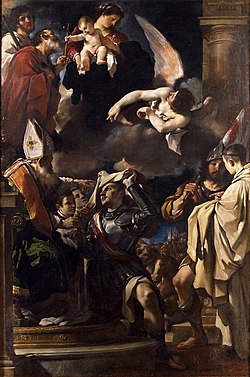Guillaume of Toulouse
| Saint William of Gellone | |
|---|---|

William of Gellone, Guillaume d'Orange, William of Aquitaine by Guercino
|
|
| Born | c. 755 somewhere in Northern France |
| Died | 28 May 812 or 28 May 814 Gellone, near Lodève? |
| Venerated in | Roman Catholic Church, Eastern Orthodox Church |
| Canonized | 1066 by Pope Alexander II |
| Major shrine | Monastery of Saint-Guilhem-le-Désert in Gellone, France |
| Feast | May 28 |
William of Gellone (c. 755 – 28 May 812 or 814), sometimes called William of Orange, was the second Duke of Toulouse from 790 until 811. In 804, he founded the abbey of Gellone. He was canonized a saint in 1066 by Pope Alexander II.
In the tenth or eleventh century, a Latin hagiography, the Vita sancti Willelmi, was composed based on oral traditions. By the twelfth century, William's legend had grown. He is the hero of an entire cycle of chansons de geste, the earliest of which is the Chanson de Guillaume of about 1140. In the chansons, he is nicknamed Fièrebrace (wild arm) on account of his strength and the marquis au court nez (margrave with the short nose) on account of an injury suffered in battle with a giant.
William was born in northern France in the mid-8th century. He was a cousin of Charlemagne (his mother Aldana was daughter of Charles Martel) and the son of Thierry IV, Count of Autun. As a kinsman and trusted comes, he spent his youth in the court of Charlemagne. In 788, Chorso, Count of Toulouse, was captured by the Basque Adalric, and made to swear an oath of allegiance to the Duke of Gascony, Lupus II. Upon his release Charlemagne replaced him with his Frankish cousin William (790). William in turn successfully subdued the Gascons.
...
Wikipedia
